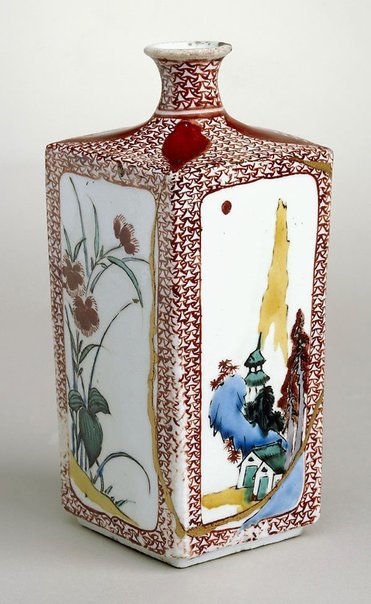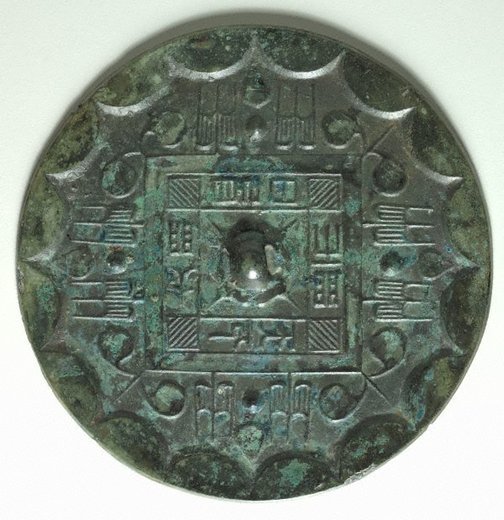
Ko-Kutani (old Kutani) is a brightly coloured Japanese porcelain or ware with striking decoration. The above squared Japanese drinking bottle coated with an extra layer of shiny coatings has four sections of the same, but not exactly similar landscape and flower patterns. It has brilliant and startling green, blue, and yellow mountains and rocks. In addition, the red trees and green pagodas at the luminous background are dazzling, which create an effect just like the other pairs of flowering ‘nadeshiko’ pinks.
The name Ko-Kutani originated from the Japanese area of Kutani, which is situated on the west coast of the main island, Honshu in the region of Kaga. In 1661, the Maeda clan started to make wares that were highly colourful and richly decorated with enamels in this region. Towards 1700, the production base could not maintain its vigour and the industry collapsed.
However, in the early period of the 18th century, the kilns were re-opened to make the next models referred to as the Ao-Kutani or the ‘green’ ware. There were speculations that the clay and colours used in the production of the wares were becoming rare. After the 18th century, potters produced the new forms of Kutani that they exported throughout the world.
The old Kutani has images and decorations that captured the lifestyle of the Japanese. In addition, they also reflected nature, plants, animals, and sceneries. Kutani differs from other forms of the Japanese pottery because of the extensive usages of bright colours obtained from plants and rocks in the region.

Chinese bronze mirrors are commonly narrow spherical objects, vaguely curved on the glowing smooth side and enamelled with sheds of designs on the opposite side. These bronze mirrors are symbolic in nature. They have a tiny ring or a curved dome in the middle of the opposite side, which serve as an attachment cord.
The earliest recognised mirrors could be traced to the period of 900s-800s BCE, Western Zhou. However, in the period of Han and Tang dynasties, several greatly decorated mirrors were made. These mirrors became items of expressing of mythological and cosmological thoughts and beliefs because of their reflective nature.
The typical ‘caoye’ or grass and leaf model consists of a regular ornamentation that looks like an ear of a corn and the trefoil forms on the focal surface of the mirror just near the central square. It has a caption at the square area that reads, ‘jianrizhiming, tianxiadaming’ (may you see the light of the sun and may the world enjoy great lightness). This indicates that the mirror design symbolises a type of cosmological harmony.
The Chinese bronze mirrors acted as items of displaying beauty and one’s image among the wealthy and complex cultures of the time. While these mirrors had goodwill massages, they were also objects of shamanism and mystery. They helped in daily beautification activities and acted as means of connecting people with aspects of life beyond comprehension. Hence, Chinese bronze mirrors were critical objects in spiritual activities.
The Chinese bronze mirror reflects ancient technologies in arts. For instance, analyses of the buried Chinese bronze mirrors have shown that some parts of the mirrors resisted corrosion that was common in iron or tin materials. The chemical permanence of the Chinese bronze mirror has resulted in metallurgical studies in the past decades.